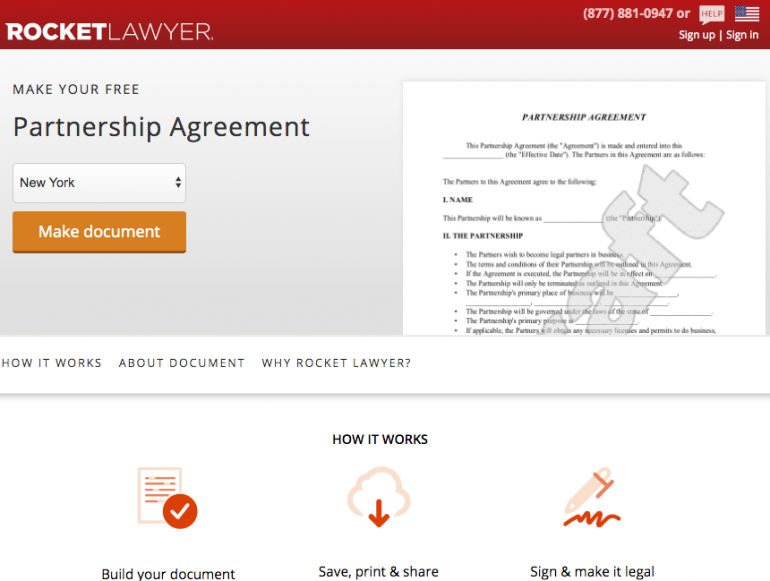Partnership Agreement: What It Is and How to Create One

Many or all of the products featured here are from our partners who compensate us. This influences which products we write about and where and how the product appears on a page. However, this does not influence our evaluations. Our opinions are our own. Here is a list of our partners and here's how we make money.
When you go into business with other people, the hope is that you’ll always work well together as a team. That's not always the case, however. One key to protecting any type of business entity is to have a solid founders’ agreement.
For partnerships, a founders’ agreement is called a partnership agreement. This article explains why a business partnership agreement is important, what you should include in your agreement — and how to create an agreement that’s effective and legally binding for all partners.
FEATURED
The importance of having a partnership agreement
A partnership agreement is a foundational document for a business partnership and is legally binding on all partners. It sets up the partnership for success by clearly outlining the business’s day-to-day operations and the rights and responsibilities of each partner. In this way, a partnership agreement is similar to corporate bylaws or a limited liability company’s (LLC) operating agreement.
There’s no state that requires a partnership agreement, and it’s possible to start a business without one. Some partners only have an oral agreement or jot down something quickly in a notebook to establish their partnership (recall all those “back of the napkin” movie scenes?). We recommend that you launch a business only after all partners sign a written, comprehensive partnership agreement. You should store the signed agreement along with other important business records.
Customize the rules for your partnership
In the absence of a partnership agreement, your state’s standard statutes on partnerships will apply. Most states have adopted the Revised Uniform Partnership Act (RUPA). The RUPA might contain provisions that aren’t suitable for your company. For example, under the RUPA, partners are entitled to an equal division of profits even if they’ve contributed different amounts of capital to the company. Some state statutes also will terminate a partnership’s existence if one or more partners leaves the company. With a partnership agreement, you can customize these and other provisions in a way that’s most appropriate for your business.
Prevents conflicts among partners
There are numerous reasons why partners might get into disagreements with each other. If you start a business with a friend or family member, you might realize that your personalities clash as business partners. One partner might not carry their weight in handling business responsibilities. It’s also common for feelings of resentment to arise when one partner contributes most of the money to the partnership, while the other contributes labor, also known as “sweat equity.”
A partnership agreement clearly outlines what each partner is responsible for and what they’re contributing to the partnership. It also specifies how important business matters are to be decided (e.g. how much of a vote each partner gets), so conflicts are less likely.
Handle business changes more easily
Changes in a partner’s life or in the wider market for your product or service can cause growing pains for a business. A new partner might want to join your business, or a partner might want to enter into a major business deal that will affect the company. A partnership agreement will address the admission of new partners and the types of actions partners can take.
Likewise, death, illness, divorce or retirement might cause a partner to leave the business.
Under some state laws, a partnership ends whenever one or more partners decides to leave the business. But most small-business owners want to see their company continue prospering even if they die, become disabled or otherwise leave the business. To make transitions easier, you can include a provision in your partnership agreement to allow remaining partners to buy out the exiting partner’s ownership interest in the company.
What to include
A partnership agreement should be customized for the specific needs of every business. We recommend using a legal template or consulting a business lawyer to draft your agreement. They’ll make sure that your partnership agreement complies with state laws and contains provisions that are most relevant to your company. The statutes in different states impact what you can customize and change with a partnership agreement.
A service like LegalZoom has lawyers licensed in every state standing by to help you launch your partnership and write up your partnership agreement.
Type of partnership
It’s important to have a partnership agreement no matter what type of partnership you have — general partnership, limited partnership (LP) or limited liability partnership (LLP). In a few states, there’s one more type of partnership called a limited liability limited partnership (LLLP). You’ll need to specify the type of partnership because the structure and features of each partnership are very different.
For instance, a limited partnership includes two types of partners — limited partners and general partners. General partners are personally liable for all the debts and obligations of the partnership. Limited partners are liable only up to the extent of their investment in the company.
Business name and address
This is pretty straightforward. You’ll want to include your partnership’s legal name, any fictitious business name/DBA that you’re operating under and business address. If your company has multiple locations, list out all the locations and identify the headquarters.
Partnership purpose and start date
In this section, provide a short overview of your company’s main product or service. You can leave this section pretty general because that will give you the flexibility to pivot and launch new products and services as your company grows. The agreement should also mention the start date of the partnership.
Partner information and contributions
Don’t forget to include each partner’s name and address in your agreement. You also should include the capital contributions of each partner, both the nature of the contributions (i.e. money, property, labor, etc.) and their value. If you have an LP, identify which partners are limited partners and which partners are general partners.
Management and control
This is perhaps the most important section of your partnership agreement. Here, you lay out each partner’s ownership interest in the business and their profit shares. These might be, but don’t need to be, equal to each other. For instance, one partner might contribute 70% of a business’s resources. Another partner might contribute just 30% of a business’s resources but bring most of the market knowledge and skills. In that case, the partners might find it fair to establish a roughly equal split of the profits.
Meetings and voting rights
Under most state laws, corporations must have regular board of director and shareholder meetings. Partnerships aren’t required to do this, but setting up a meeting schedule can help keep business matters well organized. We suggest choosing a monthly or quarterly meeting schedule and outlining the topics that will be discussed in each meeting, what constitutes a quorum for meetings and the voting rights of each partner. If you’re in a two-partner business, avoid 50/50 voting rights. Even though an even split might seem equitable, it’s often a recipe for a stalemate.
With a limited partnership, you should identify what types of issues (if any) the general partners will need to get approval for from the limited partners. Normally, limited partners don’t participate in the daily operations of the business. However, some state statutes give limited partners authority to vote on issues that affect the structure of the partnership, such as the admission of new partners or a sale of the company’s assets.
Partner liabilities
The hallmark of a general partnership is that partners share unlimited personal liability for the debts and obligations of the business. This means that, in most states, someone with a legal claim against the partnership can sue any or all general partners. Later, the general partners can sort out among themselves who’s responsible for what losses as outlined in the partnership agreement. Usually, profits and losses are allocated according to the same percentages.
Travis Crabtree, the president and general counsel of online business filing company Swyft Filings, says, “Partners can agree amongst themselves that one person is only responsible for a certain percentage of the losses. However, if the person who promised to be responsible for 80% of the liabilities, for example, cannot pay, then the person who is owed money can seek recovery from the other general partners regardless of whatever arrangement the general partners have among themselves.”
New partners and exits
Every business undergoes changes over time, and new partners might want to join the company while old partners leave. The partnership agreement should deal with both situations. An individual might become a partner, for instance, by investing capital in the company or by buying the ownership interest of an existing partner. Usually, the admission of a new partner also requires a majority vote of the current partners. You’ll need to decide if a minimum contribution is required for someone to become a partner and the partner’s profit and loss share and entitlement to distributions.
Partner exits can be as complicated as new partners entering the company. Take the example of a partner who passes away. The partner’s will might bequeath their ownership share to an heir, but the heir might have no aptitude for the business. A partnership agreement often includes buyout provisions that allow remaining partners to purchase an outgoing partner’s interest in the company. Outgoing partners (or their estates in the case of a death) are entitled to a return of any capital they invested in the company.
Finally, you’ll need to decide the grounds for dissolution of the business, though naturally, this isn’t a topic that partners like to discuss. If a certain number of partners exit the business, will this dissolve the partnership? Do all partners have to agree to dissolution or is a majority vote enough? This is an important section of your partnership agreement.
Partner compensation
Partners receive compensation in exchange for their participation in the business. They don’t receive a salary like corporate employees, but they receive a distribution or draw from the company’s profits instead. Partnership agreements can also provide for guaranteed payments, which are periodic payments that partners receive without regard to the profitability of the business (similar to a salary).
The partnership agreement should specify when partners will receive distributions and guaranteed payments. For example, the partners might agree that the business should reach a certain level of profitability first. The partnership needs to fill out IRS Form 1065 each year and give a Schedule K-1 to each partner. Partners use Schedule K-1 to report their share of business income and profits on their personal tax returns.
Non-disclosure and non-compete clauses
Small-business owners should consider putting non-disclosure agreements (NDAs) or non-compete clauses in their partnership agreement. NDAs prohibit partners from disclosing confidential information about the partnership. Non-competes have to be reasonable in time and scope but prevent a partner from starting a closely competing business or soliciting partners for a competing business.
Revisions and choice of law
A partnership agreement needs to stand the test of time, but a business goes through many changes. That is why business partners should allow the agreement to be revised as needed. In most cases, the agreement can be changed by a majority or three-quarters vote. If the partnership agreement is tested in court, you should also specify which state’s laws will apply.

Source: Rocket Lawyer
How to create a partnership agreement
One of the biggest mistakes that small-business owners make is not having a partnership agreement, so if you’ve come this far, you’re already at an advantage. There are many resources for creating your partnership agreement.
If you have a pretty simple business situation, we recommend following an online template, such as this Rocket Lawyer partnership agreement template. Rocket Lawyer will walk you through some questions step-by-step until your partnership agreement is ready to go. The agreement will also be customized for your state.
In more complex situations, we suggest consulting a business lawyer for help. There’s no substitute for personalized legal advice. For example, if you have more than two partners or if your partnership has a high amount of assets, it’s probably best to get the help of a lawyer. A lawyer is best qualified to ensure that your agreement reflects in legal terms what you and your partners might have agreed to verbally. LegalZoom has lawyers licensed in every state to help you launch your partnership and draft your partnership agreement.
Each partner must sign the partnership agreement in order for it to be binding on everyone. In most cases, electronic signatures are as good as physical signatures. You should also distribute an electronic or physical copy of the agreement for each partner to keep and store one among important business records.
A version of this article was first published on Fundera, a subsidiary of NerdWallet.


